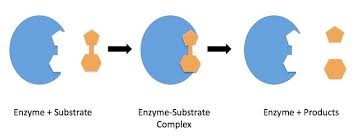The enzyme is a substance that performs as a biological organic catalyst to enhance the chemical reactions. Enzymes are produced by cells but the presence of cell is not essential for their activity. All enzymes are protein in nature. Many enzymes are simple proteins and do not require any additional factor for their activity. Some enzymes are synthesized in an inactive form called zymogens or proenzymes such as trypsinogen, chymotrypsinogen, and pepsinogen.
Some enzymes require additional factors in addition to the protein molecule for their activity. The general cofactor is used for such agents. They are divided into three groups such as:
- Prosthetic group
- Coenzyme, and
- Metal ion activator
The prosthetic group is the non-protein part of the enzyme molecule that remains closely attached to the enzyme protein. Coenzyme represents a heat-stable non-protein part of an enzyme that can be easily separated from the enzyme protein. Removal of the coenzyme leads to the loss of catalytic power of the enzyme. The protein part of such an enzyme is called an apoenzyme and the apoenzyme together with its coenzyme is called the holoenzyme.
Nicotinamide adenine dinucleotide (NAD) is synthesized from vitamin niacin and thiamine pyrophosphate (TPF, synthesized from vitamin B1) are an example of such coenzymes. Metal ion activator-a large number of enzymes require metallic mono or divalent cations such as K+, Mn++, Mg++, Ca++ and Zn++ for their activation.
Enzymes are known to influence the rate of biochemical reactions in several ways. In a number of cases, the coenzyme first reacts with the substrate to form a new compound. In the next step, the intermediate compound thus formed undergoes a second change in which the enzyme is liberated in its original form and the substrate in an altered form called product.
Properties of Enzymes
- Enzymes are proteins that are easily affected by pH, heat and heavy metal ions.
- Enzymes work very rapidly in the chemical reactions.
- Enzymes are not destroyed after the completion of reactions and thus the enzymes can be reused.
- An enzyme can work in both directions.
- Enzymes are inactivated by excessive heat.
- Enzymes act as to catalyze and they are specific in the chemical reactions.
Naming of Enzymes
Generally enzymes are named by adding the suffix ‘ase’ after the name of the substrate on which it acts; for example, lactose is degraded by the enzyme lactase(similarly maltose by maltase, sucrose by sucrose, cellulose by cellulase, etc). Some enzymes are named according to the nature of the chemical reactions they catalyze such as dehydrogenases remove hydrogen from the substrate molecules, carboxylases add or remove carbon dioxide, etc
Classification of Enzyme
Enzymes are classified into six main categories as stated below:
1. Oxydoreductages: These groups of enzymes catalyze oxidation-reduction reaction and transfer the electrons. Examples: dehydogenases, oxidases, etc.

2. Transferases: These types of enzymes move functional group from one molecule to another. Example: transaminases, kinases, transacetylases, etc.

3. Hydrolases: Enzymes belonging to this group bring about lysis of a variety of compounds by the addition of water molecules (H2O). Examples: amylasaes, lipases, phosphatases, peptidases, etc.

4. Lyases: These enzymes catalyze the removal of groups from substrate without the addition of water molecule. Generally, they split chemical bonds and often add double bonds.

5. Isomerases: Enzymes catalyze a wide variety of isomerization reactions.

6. Ligases: Enzymes catalyzing the linking together of two molecules coupled with the lysis of a pyrophosphate bond. Usually a triphosphate nucleotide such as ATP participates in the reaction.

What do enzymes perform?
- Enzymes regulate the biological processes and the rate of a chemical reaction within the living organisms.
- Enzymes help to break down the toxins in the body.
- It helps to break down the larger complex molecules into smaller molecules.
- Enzymes help to unwind the DNA coils and copy the information during DNA replication.
- It helps to boost up the chemical reactions.
Some specific Enzymes and Their Functions
In the human body, there are lots of enzymes. Among them, the functions of some specific enzymes are stated below:
- Lipases: They are a group of enzymes which help to digest fats in the gut.
- Amylase: This type of enzyme is found in saliva which helps to change starches into sugars.
- Trypsin: This type of enzyme is found in the small intestine and it helps to break down proteins into amino acids.
- Lactase: It is also found in the small intestine which breaks down lactose of milk into glucose and galactose.
- Maltase: It is also found in saliva which helps to break down the sugar ‘maltose’ into glucose.
- Helicase: It unknots the DNA coil during DNA replication.
- Acetylcholinesterase: It is a primary enzyme which acts as a neurotransmitter and breaks down acetylcholine into choline and acetate in nerves and muscles.
- DNA polymerase: It helps to synthesize DNA from deoxyribonucleotides.

